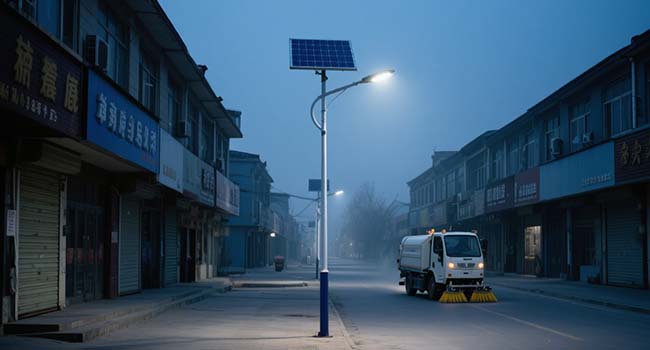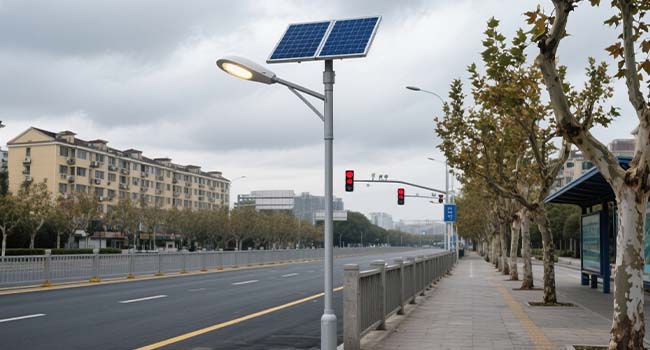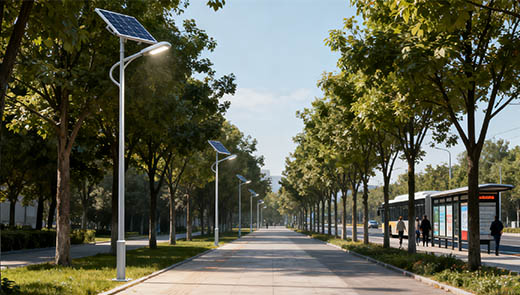Flickering Street Lights: Causes, Solutions, and Danger Prevention
As a core component of urban infrastructure, the stability of street lighting directly impacts public safety, resident health, and city operational efficiency. However, the issue of flickering street lights has long been underestimated, with its hazards extending far beyond mere visual disturbance. Research indicates that flickering not only significantly increases traffic accident risks and causes chronic health damage but also leads to substantial energy waste and public expenditure. This article conducts an in-depth analysis of the mechanisms behind flickering, its multidimensional hazards, and systemic solutions, while exploring how technological upgrades can achieve long-term safety and sustainable development.

The Hidden Dangers of Flickering Street Lights
Safety Risks
The threat flickering poses to traffic safety is both immediate and insidious. When lights flicker at low frequencies (typically below 100Hz), the human eye experiences a persistence of vision effect, causing drivers to encounter “visual blind spots” or “brightness illusions” during high-speed travel. A 2022 U.S. Department of Transportation study revealed that accident rates on sections with unstable lighting are 25% higher than on standard roads, with flickering contributing to 40% of rear-end collisions and skidding incidents.
Furthermore, flicker impairs pedestrian recognition—experiments demonstrate that under 50Hz flicker, drivers take 0.3 seconds longer to identify road obstacles. At 60km/h, this equates to traveling an additional 5 meters, potentially causing fatal collisions in high-density urban areas or during rain/snow.
Health Impacts
The health hazards of flicker are long-term and vary by population. The International Commission on Illumination (CIE) classifies flicker into “visible flicker” (frequency < 70Hz) and “invisible flicker” (frequency > 100Hz). The former directly stimulates retinal nerves, causing eye strain, headaches, and even migraines. More critically, photosensitive individuals (such as epilepsy patients) may experience photosensitive seizures triggered by flicker. Elderly individuals, with diminished retinal function, exhibit lower tolerance thresholds, resulting in exponentially increased health risks.
Economic Costs
The economic toll of flicker far exceeds intuitive expectations. In terms of maintenance costs, flicker accelerates luminaire aging—experimental data shows LED Street lights with frequent on/off cycles have lifespans over 50% shorter than steadily operating fixtures. This forces public sectors to replace Street lights every 2–3 years, whereas standard fixtures last 8–10 years. Energy waste is equally alarming: under flickering conditions, actual lamp energy consumption exceeds rated values by 15%-20%, while power losses from supply fluctuations account for 3%-5% of total grid losses.
Why do LED Street Lights Flicker?
LED Driver Power Supply
LED require constant current to maintain stable luminous efficacy. However, some drivers use simplified circuit designs to reduce costs, causing output current fluctuations exceeding ±10%. When grid voltage fluctuates or load changes abruptly, the driver may enter protection mode, implementing “soft start” through intermittent power cuts, which causes visible flickering in street lights.
LED Light Beads
The rated current of LED street light beads must precisely match the driver's output current. If the driver current is too high (e.g., bead rated at 300mA but driver outputs 500mA), the bead overheats and cycles on/off frequently. If the driver current is too low (e.g., bead rated at 700mA but driver outputs 500mA), the bead fails to illuminate fully, causing “dark flicker.” Experimental data indicates that the probability of flickering and LED lifespan in mismatched scenarios differ significantly from matched scenarios:
|
Matching Condition |
Flicker Probability |
LED Lifespan |
|
Strict Current Matching |
5% |
50,000 hours |
|
Overcurrent / Undercurrent |
35% |
15,000 hours |
Connections or Circuits
Loose connections in Street light circuits are a common physical cause of flickering. Oxidation at terminals, loose screws, or damaged cables increase contact resistance, causing localized overheating when current flows and triggering intermittent circuit breaks. Such issues are prevalent in multi-light series circuits—if distribution box connections are loose, it may cause Street lights along an entire stretch to flicker simultaneously.
LED Bulbs or Fixtures
Low-cost LED fixtures often use low-purity phosphors, thin aluminum substrates, or non-waterproof encapsulation to reduce costs. This results in rapid lumen depreciation, poor heat dissipation, and susceptibility to moisture-induced short circuits. For instance, non-waterproof fixtures have a failure rate three times higher than waterproof ones in humid environments. Fixtures with lumen depreciation exceeding 30% may flicker due to current compensation requirements. Additionally, low-quality drivers exhibit weak interference resistance, making them susceptible to grid harmonics that induce low-frequency modulated flicker—particularly noticeable at night.

Waterproofing
Street lights endure prolonged outdoor exposure to rain, dust, and temperature fluctuations. Insufficient waterproofing (e.g., below IP54) allows moisture to infiltrate driver compartments, causing circuit board short circuits or component corrosion that triggers flicker. A 2021 Street light failure survey in a coastal city revealed that waterproofing failures accounted for 22% of malfunctions, with 60% of these cases exhibiting flickering symptoms. Design flaws like deteriorated waterproof gaskets and clogged drainage holes further accelerate internal water accumulation, shortening the failure cycle.
Dimmers
Traditional dimmers control brightness through rapid switching, whereas LED require constant-current dimming—fundamentally different operating principles. When incompatible dimmers are paired with LED Street lights, the dimmer sends pulsed signals to the driver power supply, causing frequent LED chip activation and deactivation, resulting in visible flickering.
For example, using a dimmer with a 0-10V dimmable LED fixture results in nearly 100% flickering probability, with increased flicker during brightness adjustment. Replacing it with a dedicated LED dimmer immediately eliminates flickering and enables smoother brightness control.
Solutions for Flickering LED Street Lights
Check the Power Supply
Install an Automatic Voltage Regulator (AVR) in the Street light distribution box to compress input voltage fluctuations from ±20% to ±5%. This ensures the driver power supply operates within a stable range, preventing sudden voltage spikes or drops from triggering protection mode. Additionally, prioritize drivers supporting wide input voltage ranges covering most global grid voltages. This is particularly effective in older urban areas or suburbs with significant grid fluctuations, enhancing power supply stability through broad voltage compatibility.
Upgrade to an LED-Compatible Dimmer
Select LED dimmers precisely according to LED Street light driver protocols, prioritizing dedicated PWM dimmers to ensure full compatibility between dimming signals and driver power supplies. Simultaneously, scientifically control the dimming range to avoid exceeding 90% dimming depth (i.e., brightness no lower than 10%), preventing the driver from entering unstable states due to excessively low load. Additionally, set a “flicker detection threshold” within the dimming system; upon detecting flicker, it automatically adjusts the output current to achieve dynamic stability.
Replace the Driver
As the “heart” of LED Street lights, driver selection must prioritize three critical parameters: Power Factor Correction (PFC) ≥ 0.95 to reduce grid harmonic interference and mitigate low-frequency flicker risks; Output current ripple < 5% to ensure stable current delivery to LED and prevent brightness fluctuations; Incorporate quadruple protection against over voltage, over current, short circuits, and overheating, with a fault self-recovery time < 0.1 seconds to prevent fault escalation.
Reduce Circuit Load
Utilize power monitoring systems to analyze Street light circuit loads in real time, preventing high-power appliances (e.g., advertising screens, traffic signals) from sharing circuits with Street lights. This mitigates the impact of sudden load changes on Street light power supply. For instance, one city reduced Street light flickering by 60% after separating Street light circuits from advertising screen circuits. For high-density lighting areas like commercial streets and overpasses, deploy dedicated cables to lower line impedance and enhance power stability. This facilitates future load adjustments and fault diagnosis, laying the foundation for long-term reliable operation.

Invest in High-Quality LED
Prioritize luminaires with IP65 or higher waterproof ratings. Coastal and rainy regions should upgrade to IP67 to ensure reliable operation during heavy rain and dusty conditions. After adopting IP67 luminaires, a coastal city reduced water ingress-related flickering failure rates from 18% to 2%.
For thermal management, select fixtures featuring aluminum heat sink fins + high-thermal-conductivity silicone gel to maintain driver temperatures below 60°C. This delays component aging and reduces flickering caused by inadequate heat dissipation. Additionally, require suppliers to provide a 3-year or longer warranty, transferring post-installation maintenance risks to them and lowering public expenditure costs.
What Kind of LED Street Lights Resist Flickering?
Core Performance Guarantees
Built-in active PFC circuitry supports 90-305V AC wide voltage input with 6kV surge resistance (withstands lightning strikes and sudden voltage spikes). Output current ripple < 3% ensures no visible brightness fluctuations in LED lamp beads.
Wide Voltage Adaptability
Maintains flicker-free operation even with ±20% voltage fluctuations, preventing driver protection mode activation during voltage spikes. Ideal for older urban areas and suburban regions with unstable power grids, ensuring reliable Street light performance in complex grid conditions.
High-Efficiency Heat Dissipation Design
Features 6063-T5 aluminum alloy heat sink fins (20% higher heat dissipation efficiency than standard aluminum), with a heat dissipation surface area of 0.5m² per fixture. Combined with high-thermal-conductivity silicone filling the gap between the LED chip and heat sink, this keeps the driver temperature stable below 55°C. This not only keeps LED light decay below 5% per year but also fundamentally reduces flicker caused by component aging, extending the overall lifespan of the Street light.
Sealed Waterproof Construction
LED Street lights meet IP65 protection rating (dustproof and splashproof). For demanding environments (e.g., coastal installations), they achieve IP67 and pass 96-hour salt spray testing. This effectively withstands coastal, high-humidity, and dusty outdoor conditions, preventing water ingress that causes circuit failures and flickering, ensuring long-term stable operation.
Smart Dimming and Monitoring
Select Street lights support light sensing, time-controlled operation, and remote dimming with flicker-free adjustments. Integrated flicker monitoring functions provide real-time status feedback to management platforms, enabling proactive hazard detection. The system reduces nighttime brightness to 30%, achieving 30% energy savings while employing a “low-brightness stabilization program” to eliminate flicker risks under low-load conditions.
Street light flickering is not a “minor issue,” but rather a “systemic hazard” impacting public safety, resident health, and urban economies. Technically, flickering can be effectively mitigated through optimized driver power supplies, standardized circuit maintenance, and compatible equipment selection. Long-term adoption of anti-flicker LED Street lights not only reduces traffic accident rates and chronic health impacts but also extends luminaire lifespan and conserves energy consumption, supporting sustainable urban development.




